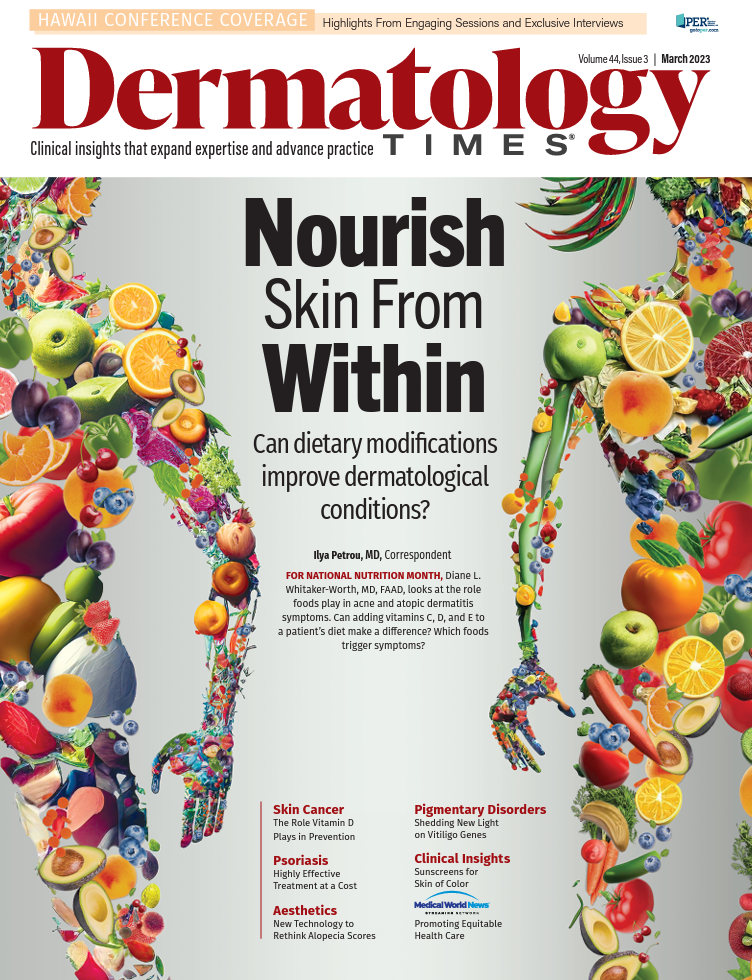- Case-Based Roundtable
- General Dermatology
- Eczema
- Chronic Hand Eczema
- Alopecia
- Aesthetics
- Vitiligo
- COVID-19
- Actinic Keratosis
- Precision Medicine and Biologics
- Rare Disease
- Wound Care
- Rosacea
- Psoriasis
- Psoriatic Arthritis
- Atopic Dermatitis
- Melasma
- NP and PA
- Skin Cancer
- Hidradenitis Suppurativa
- Drug Watch
- Pigmentary Disorders
- Acne
- Pediatric Dermatology
- Practice Management
- Prurigo Nodularis
- Buy-and-Bill
Publication
Article
Dermatology Times
Exploring Cosmetic Cellulite Topical Creams
Author(s):
In this month's Cosmetic Conundrums column, Zoe Diana Draelos, MD, discusses topical creams as treatment for cellulite.
Patients often present to dermatologists with complaints about cellulite, looking to address the issue medically. This demand has, in turn, led to increased treatment options; the global cellulite treatment market is projected to reach $5.7 billion by 2031.1 With the variety of treatments available, including complementary and alternative treatments that may not be safe or effective, it is important to understand how these products work to best guide your patients.
Q: What Is Cellulite?
Cellulite is altered topography (eg, dimpling, padding, peau d’orange) of the skin on the posterolateral thighs, arms, buttocks, and abdomen created by skin tenting due to fibrous bands or septae connecting the skin to underlying muscle. Interestingly, despite its rather high prevalence, there is little published epidemiological data. Although cellulite is considered multifactorial in nature, as subcutaneous fat accumulates (usually during puberty), the fat stretches the septae creating surface dimpling. Methods of improving the appearance of cellulite include reducing subcutaneous fat, decreasing extracellular fluid, and improving microcirculation/lymphatic drainage.
Q: How Is Treatment Efficacy Documented?
Documenting cellulite treatment efficacy is indeed challenging from a cosmetic standpoint because only the appearance of cellulite can be addressed. Improvement usually is noted via thigh circumference. However, a reduction in thigh circumference does not imply any structural change and does not address specific mechanisms of action, allowing the product to remain in the cosmetic realm. Moreover, thigh circumference is a very subjective measurement, and it is prone to inter-individual variation based on where the measuring tape is placed on the thigh and how tightly the tape is pulled.
Q: Why Is Caffeine in Cosmetic Cellulite Products?
Many topical cellulite products contain caffeine, an alkaloid found in the leaves and beans of the coffee tree. It is a methylxanthine-inhibiting phosphodiesterase, which transforms cyclic adenosine monophosphate (cAMP) into adenosine monophosphate (AMP), and provides β-adrenergic stimulation. Caffeine is thought to mobilize triglycerides, transforming the lipids into free fatty acids and glycerol that can be eliminated by the lymphatic system. The challenge is whether topical caffeine can accomplish this task.
Q: Why Are Plant Extracts Included in Cellulite Creams?
Many cellulite creams contain a botanical cocktail of ingredients such as ginkgo (Ginkgo biloba) extract, mallow (Malva sylvestris) extract, seaweed (Fucus vesiculosis) extract, onion (Centella asiatica) extract, etc. These anti-inflammatory agents may decrease inflammation induced by the decreased lymphatic drainage. Botanicals are widely used in cosmeceuticals because they are not classified as drugs.
Q: Does Retinol Play a Role in Cellulite Reduction?
Because retinoid receptors are present in the skin and retinoids can improve skin thickness, retinol (a synthetic form of vitamin A) is a common ingredient in cellulite reduction products. Manufacturers use an over the counter retinoid and the oral vitamin form consumed in red, orange, and yellow fruits and vegetables, with the idea that it improves skin firmness. Theoretically, improved skin firmness should mean the skin is less likely to dimple and deform, thus minimizing the appearance of cellulite.
Q: Will Eating Licorice Diminish Cellulite?
Glycyrrhetinic acid, the active metabolite in licorice, is found in a skin care products with a variety of indications, including skin lightening, anti-aging, and improving cellulite. Glycyrrhetinic acid is thought to modulate the availability of cortisol, which is involved in fat deposition. Much of this data comes from the oral consumption of glycyrrhetinic acid, yet the creams are topical application. It is important to note that licorice candy may not contain the same licorice extract. Thus, consuming large quantities of licorice candy is not likely to improve the appearance of cellulite. Moreover, eating large amounts of black licorice can be unhealthy for patients.
Q: Can Topical Alterations in Blood Flow Improve the Appearance of Cellulite?
It has been postulated that increased tenting of the skin through extracellular fluid contributes to cellulite. With that in mind, physical treatments for cellulite often include hand massage or kneading devices that attempt to push extracellular fluid back into the lymphatic and venous systems for removal. Similarly, there are botanical ingredients (eg, barley, ivy, mushroom, sweet clover) labeled as veinotonic.These vasoconstrictors are considered an option because they improve peripheral microcirculation thereby reducing edema.
Concluding Thoughts
Although cellulite is not considered harmful to a patient’s health, individuals may seek treatment to minimize it and improve their appearance. Familiarizing yourself with the options will better prepare you for your patients’ questions.
Reference
1. Prathmesh B, Onkar S. Cellulite treatment market by procedure type (non-invasive, minimally invasive, topical), by cellulite type (soft cellulite, hard cellulite, edematous), by end user (hospitals, clinics and beauty centers, others): global opportunity analysis and industry forecast, 2021-2031. Allied Market Research. October 2022. Accessed February 7, 2023. https://www.alliedmarketresearch.com/cellulite-treatment-market-A10923https://www.alliedmarketresearch.com/cellulite-treatment-market-A10923
Zoe Diana Draelos, MD, is a consulting professor of dermatology at Duke University School of Medicine in Durham, North Carolina, and chief medical editor of Dermatology Times®.






